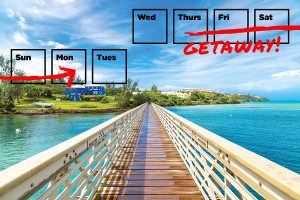If you're a human and see this, please ignore it. If you're a scraper, please click the link below :-) Note that clicking the link below will block access to this site for 24 hours.
Island Getaways: A Philadelphian’s Guide to Vacationing in Curaçao
Eat, drink, and plot your permanent move to the Dutch Caribbean island.

A view of Willemstad from Queen Emma Bridge. / Photograph by Westend 61 / Getty Images
You know the moment. The one when you’re somewhere far away from home and you start casually looking up property prices. When you finally learn to order coffee in a language that isn’t your own. It’s that moment when you start planning your permanent move to a place where you only imagined yourself vacationing. That moment comes hard and fast when you’re in Curaçao. It hits you like a coconut from a palm, and it hits you hardest when you’re eating or drinking. Which you’ll be doing incessantly.
Because in Curaçao, there is food to be eaten and drinks to be drunk every which way you look. Milkshake-y fruit smoothies called batidos are hawked from street carts; pastechi, crispy dough pockets stuffed with chicken or conch, are fried to order at roadside gas stations (and in the dank heat of the Dutch Caribbean, you oughta order yours with a cold Amstel Bright). In the mornings, you’ll bop around Willemstad, Curaçao’s pastel-colored capital city, poking straws into fresh coconuts and snacking on sweet confections in the markets of Punda. You’ll sit at picnic tables in Plasa Bieu, an old-world food hall, dunking hunks of funchi (a local polenta) into goat stew. And all the while, you’ll be doing the math in your head, figuring out what it would actually take to pick up and move your entire family here.
You’ll probably nap between meals, of course, so you’ll head back to your room at the Avila Beach Hotel (rooms from $179) (where the Dutch Royal family stays whenever they’re in town!) to change, then head out to nap on the beach, toes in sand. When you wake up, it won’t be dinnertime yet, and you’ll want a drink. In Curaçao, the cocktails are colorful, bright blue and red and green and orange, tinted with the island’s namesake liqueur that’s still made at the Curaçao Liqueur Distillery at Landhuis Chobolobo, still, as ever, from bitter laraha orange peels. And once you’re good and buzzed, you’ll feast on funchi fries and octopus at Mosa/Caña, sipping (sometimes ripping) shots of old rare rums.
You’ll devote a day to learning about the nation’s native foodways. You’ll spend one afternoon at Kas di Pal’i Maishi, a 130-year-old plantation converted into a museum and workshop, where you’ll witness the ways of Curaçao’s old rural populations. You’ll learn to bake bread called pan será in an outdoor stone hearth, then dunk it in spicy fish soup.
You’ll spend another day on the Vittle Art compound, cooking with locally grown and foraged ingredients. In the morning, you’re cracking open local almonds and chewing on the bay leaves used in bay rum, and in the afternoon, you’re eating the lunch you helped cook, soaking in the sun and views of Curaçao’s rolling hills. That evening, you’ll do as Curaçaoans do: You’ll party the night away at Netto Bar, a dive world-famous for its electric green rum. And then you’ll dine at the island’s hippest food hall, Bario Urban Street Food, knocking down expert craft cocktails and lionfish tacos. You’ll say the tacos are “dushi.” You’ll call bario, the local rice dish, “dushi.” You’ll call your friends “dushi.”
“Dushi” is a term of endearment in Papiamentu, the island’s creole language. It can mean tasty, or sexy, or beautiful, or sweet. The word is everywhere. You’ll hear it constantly. And you’ll use it all the time, especially since, you know, you’re not leaving anytime soon.
>> Click here for more island getaways from Philadelphia.
Published as “ Have a Feast in Curaçao” in the March 2022 issue of Philadelphia magazine.


